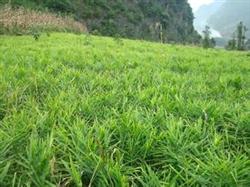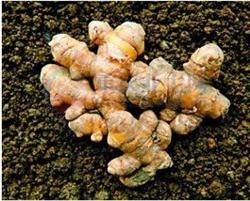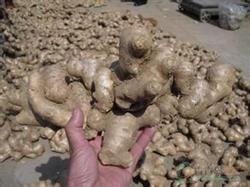High-yield formula fertilization technology of ginger

Ginger has a long growing period and needs a lot of fertilizer. Under medium fertility conditions, it usually yields 2500 kg ginger per mu. It needs to apply 25~40 kg N, 10~22 kg P 2O 5 and 30~50 kg K 2O. The absorption ratio of N, P and K is 11∶1∶16 or 1∶0.5∶2. In addition, it also needs middle and trace elements such as Ca, Mg, B, Zn and Fe. Due to different nutrient requirements at different stages, yield and quality can be improved by formula fertilization. 1. The root system of ginger is thin and weak, and the distribution is shallow. Heavy application of basal fertilizer is the key to high yield. Before soil preparation, 2500~5000 kg of decomposed chicken manure was sown per mu, and after fertilization, 3 rows of ginger were planted in the whole ridge with width of 1.2 m, width of furrow 30 cm and depth of furrow 20 cm, or 4~5 rows of ginger were planted in the whole ridge with width of 2~2.4 m, width of furrow 40 cm and depth of furrow 40~50 cm. 75 - 100 kg cake fertilizer and 15 - 20 kg ternary compound fertilizer are used per mu before sowing, crushed and applied into the sowing ditch and mixed evenly with soil, then watered and sown. In the ginger field lacking zinc and boron, 1~2 kg zinc sulfate and 0.5~1 kg borax per mu can be mixed evenly with fine soil or organic fertilizer, and applied to the sowing ditch and mixed evenly with the soil when sowing. 2. 2~3 times of topdressing should be applied to ginger during its growth period. 0.05%~0.1% Zn and B fertilizer should be sprayed 2~3 times at seedling stage, growth stage and rhizome expansion stage in ginger fields deficient in Zn and B. 1. Apply "strong seedling fertilizer" lightly for the first time. The seedling stage (i.e.,"three-branched") takes 65~75 days from leaf spreading to having two larger lateral branches. The growth of young plants is small, but the growth period is long. Usually, the first topdressing is carried out when the seedling is 25~30 cm high and has 1~2 branches. The top dressing is mainly nitrogen fertilizer, and 1000~1500 kg of decomposed human excrement or 4~5 kg of urea are applied per mu, which is washed in with water when it is applied to the furrow or watered. If the sowing period is too early and the seedling stage is longer, 2~3 times of fertilization can be carried out with watering, and the amount of fertilization is the same as above. (2) Re-apply "split fertilizer"(or "branch fertilizer","turning fertilizer", etc.) for the second time. From late July to early August, ginger seedlings were in the stage of "three branches", and the demand for fertilizer and water increased, so topdressing should be combined with weeding in ginger field. Generally, cake fertilizer or farm manure is combined with quick-acting chemical fertilizer, 1500~2000 kg of decomposed human manure is applied per mu, and 25~50 kg of ternary compound fertilizer is added. A fertilizer ditch is opened at the position 15~20 cm away from the plant base on one side of ginger seedlings, and the fertilizer is sprinkled and mixed with the soil. Then, the ditch is covered with soil, the ridge is cultivated, and finally the water is poured thoroughly. If the weather is dry, irrigate once every 4~6 days to keep the soil relative humidity at 75%~80%. Cultivate 3~5 times to the base of the plant to make its rhizomes expand. When the ginger seedlings grow to 19.8~23.1 cm high, the hidden buds on the ginger mother should be removed in time to avoid wasting nutrients. When the ginger seedlings grow to 35~45 cm high, one or two buds grow from both sides of the ginger mother, and these buds should be preserved. (3) The third time, skillfully applying "swelling fertilizer"(or called "strong ginger fertilizer" or "supplementary fertilizer"). From late August to early September, when ginger seedlings had 6~8 branches, topdressing could be carried out for the third time. Generally, 200~250 kg of decomposed cake fertilizer or 25~30 kg of ternary compound fertilizer are applied per mu. Furrow irrigation or watering is used at the same time of fertilization to prevent root burning. When the weather is dry, irrigate once every 10 days or so, and water in the morning and evening in the high temperature season; immediately drain after rainstorm to make the furrow unblocked. For ginger fields with weak growth or general growth and low soil fertility, quick-acting chemical fertilizers, especially potassium and nitrogen fertilizers, should be applied, while for ginger fields with good soil fertility and vigorous plant growth, less or no nitrogen fertilizer should be applied. Ginger likes cool and humid, not resistant to high temperature and strong light, when the weather is hot, it is necessary to set up a shed to shade, and the top center of the ginger plant should be knocked off in the middle of August, and it should be beaten once every 7 to 8 days for 2 to 3 consecutive times; in late August, the ginger branches and leaves have been lush, and the ginger shed can be removed at this time. 3 days before harvest last watering, so that harvest ginger with moist soil, conducive to storage. Harvesting usually takes place in mid-to-late October before the early frost arrives.
- Prev

Comprehensive Control techniques of Ginger Rot
1. Choose disease-free ginger seeds and seed ginger for disinfection. Leave seeds from disease-free areas or select disease-free ginger, soak the seeds before sowing with 50% carbendazim wettable powder for 6 hours, or soak the seeds with 2000 times of neophytin for 24 hours. two。 Ginger selection and disinfection. The pathogen can survive in the soil for more than 2 years.
- Next

Storage technology of ginger
Ginger is a perennial herb of Zingiberaceae. It is not only a commonly used traditional Chinese medicine, but also an important vegetable for export to earn foreign exchange. Due to the wide use and large amount of ginger, coupled with the characteristics of warm and cold, wet and dry, it is particularly important to do a good job of ginger storage and preservation. First, before storage.
Related
- Where is it suitable to grow horseradish in China? it is expected to see the middle altitude horseradish in Alishan.
- How to prevent tomato virus disease reasonably? (Control methods included)
- Many people like to plant towel gourd on the balcony. What are the main points of this method and management?
- What crops can chili peppers be mixed with?
- Fertilization techniques and matters needing attention in Tomato
- What are the grafting techniques for peach seedlings in spring?
- Harm and control methods of root swelling disease of Chinese cabbage
- What are the pests of sweet potatoes? How to prevent and cure it?
- Symptoms, causes and Control methods of navel Rot in Tomato
- The cause of "Cucumber rotten bibcock" in Farmers' planting Cucumber and its Control Plan

